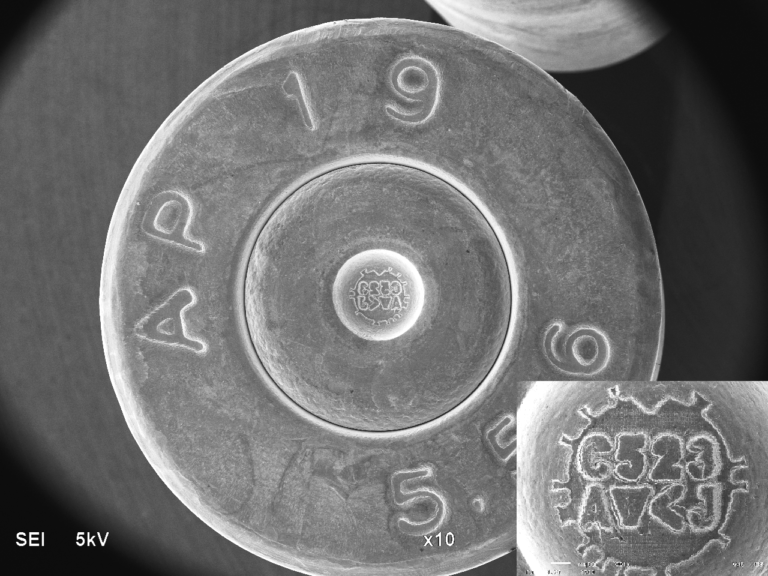
The Bloomberg anti-gun group Everytown for Gun Safety has posted a defense of the impracticable microstamping technology on its The Smoking Gun web site. The article has enough glaring errors and omissions that a response is warranted. You can read the article for yourself here.
My previous article explaining Kamala Harris’s dishonest role in implementing the microstamping mandate can be found here. I’m not sure if my article had any role in prompting Everytown’s out-of-the-blue defense of the non-existent technology, but I’ll assume the timing is coincidental. I’d be flattered to learn that they pay close attention to my X feed (despite their having blocked me long ago).
Let’s take a look at the specific claims in the article:

Even assuming microstamping is feasible, this is an immediately silly argument. Only an exceptionally unintelligent criminal would ever be caught due to microstamping because it can so easily be defeated by a variety of methods:
-
The firing pin can be filed down to destroy the microstamp.
-
The firing pin could be replaced with another.
-
If time allows, the spent shell casings could be picked up at the scene of the crime.
-
The criminal could simply opt to use a revolver, which does not eject casings.
But most important, microstamping would often fail to help solve crimes because criminals frequently use stolen guns. This has been confirmed by the antigun publication The Trace (which shares some of the same leadership and funding sources as Everytown) in an article about a study earlier this year which found that “guns reported lost were three times more likely to be used in crimes, while stolen guns had nearly nine times the likelihood.”
If an unknown thief were to steal a microstamped handgun, the most the stamp could tell you (if the thief didn’t file down the firing pin or replace it) is who the original legal buyer of the gun was.
Regardless, if microstamping ever became a reality, it would quickly become common knowledge for criminals to make sure not to use a gun they directly purchased in their crimes. Or if they did, to change or file down the firing pin.
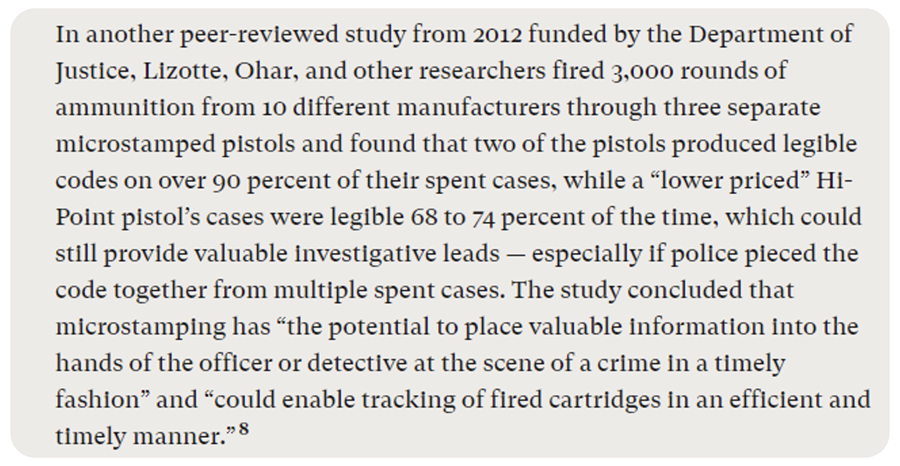
Everytown concedes a critical point here: microstamps wear off over time. So even if a criminal is dumb enough to use a gun they purchased themselves and didn’t file down or replace the firing pin, the microstamp won’t be legible if the gun had been fired a moderate number of times. (Everytown probably thinks 3,000 rounds sounds like a lot, but for many, that’s a handful of range trips.)
The fact that microstamps erode much faster in laboratory settings with cheaper guns is even more damning to Everytown’s arguments, as cheap guns are used more frequently in crimes.

If the cost is so inexpensive, why hasn’t anyone done it yet on a mass scale? Making microstamped firing pins for lab tests is one thing. Mass producing them is entirely another.
At California Rifle & Pistol Association’s preliminary injunction evidentiary hearing in Boland v. Bonta, we presented an expert witness to discuss why mass production of microstamped firing pins was “not suitable for mass implementation.” The state failed to present anyone to argue the opposite, including the people Everytown cites in this report.
As the District Court’s order explained:

If the supposed experts that Everytown cites disagree with Mr. Beddow’s conclusions, it’s more than curious why the California Department of Justice didn’t have them show up for the evidentiary hearing. The state presented other expert witnesses to support other aspects of the case, but not regarding microstamping.
The Everytown article then goes through the history of the legislative side of how microstamping was enacted, including this tidbit:
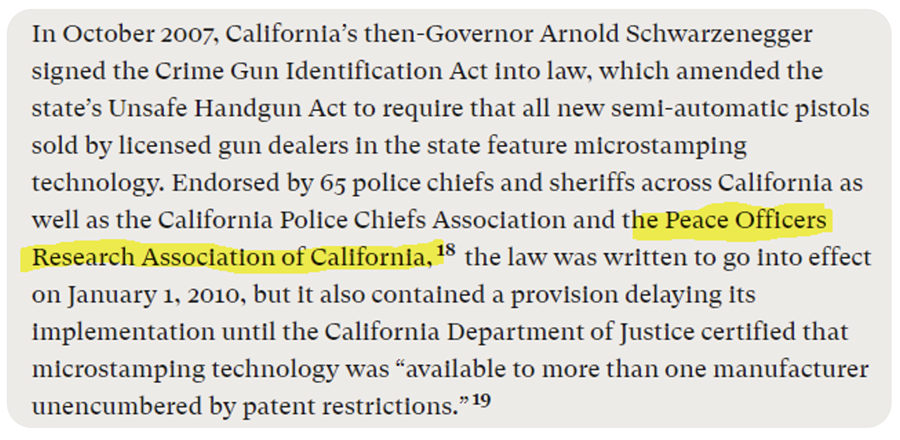
That is a strange inclusion in the article because PORAC is now on the other side. Whatever the reasoning for their 2007 position may have been, they wrote in an amicus brief in support of CRPA in Boland stating that: “the UHA’s microstamping requirement has little impact on deterring individuals who commit crimes with firearms, as they typically use stolen firearms” and that “microstamping—even if actually in existence—would provide little assistance to law enforcement.”
Everytown should really do a better job of checking on the current positions of the experts it cites. Microstamping may have sounded promising back in 2007, but its impracticality has turned some old proponents into opponents.

It’s comically misleading for Everytown to simply describe CRPA’s case as “ongoing,” but leave out that the microstamping requirement was declared unconstitutional. And, even though the state asked for a stay on other aspects of the lawsuit CRPA won, they didn’t on microstamping. Everytown is well aware of this, because they submitted an amicus brief that barely made the case for microstamping…and certainly included none of the claims of its supposed feasibility they presented in this misleading article.
While we drew a tough Ninth Circuit panel on appeal (where a ruling is still pending), even that unfavorable panel seemed very skeptical of microstamping at oral argument, video of which is available here.
California then responded by passing a law that repealed microstamping, with possible plans to bring it back in 2028 if a series of steps are met. In its article, Everytown tried to spin its loss as a win, writing that:
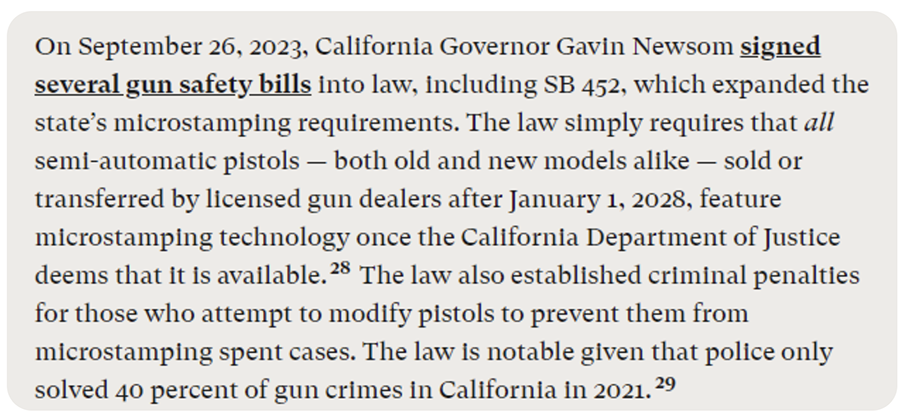
The obvious problem here is that then-Attorney General Kamala Harris already deemed the technology viable and available over a decade ago. So Everytown seems to be admitting here Kamala Harris was lying at the time.
The idea that those intent on committing crimes will care about laws making it illegal to modify pistols to defeat microstamping technology is perhaps the most preposterous claim made in this article. Someone who wants to commit a violent crime isn’t going to decide not to because they’d have to break the law by filing down or replacing their firing pin.
Under the new law, the California DOJ is empowered to try to mass produce microstamped firing pins themselves by contracting with outside vendors claiming to be able to make them. I’m very eager to see how they do.
Finally, I want to touch on the running theme of this whole problematic article, which is that microstamping is possible but that evil gun companies, the NSSF, and the NRA are undermining it by refusing to go along with implementing the technology. The entire last third of Everytown’s article focuses on this point.
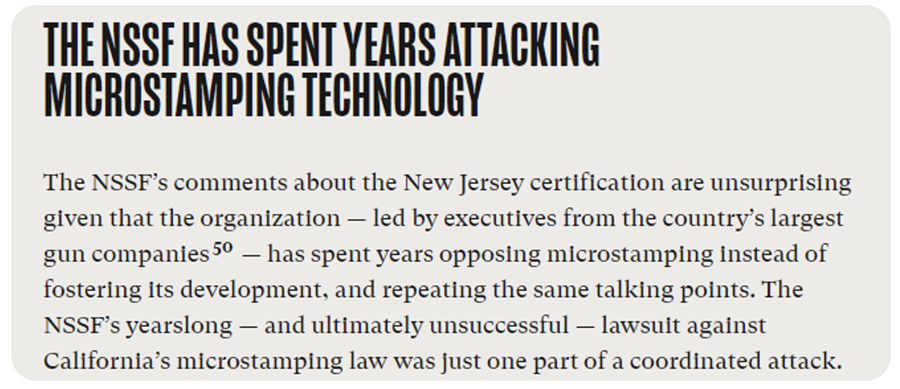
This argument just doesn’t ring true because gun companies are for-profit businesses and California is a huge market. If microstamping were feasible on a mass scale, I’m sure companies would have given in to the profit motive at some point in the last decade when Californians being starved for new pistols and could only buy older, grandfathered models.
That’s proven when you see the other requirements of the California handgun roster. Aside from microstamping, CRPA also sued to enjoin the magazine-disconnect mechanism and loaded chamber indicator requirements. We prevailed in the district court, but that was stayed by the Ninth Circuit. We believe those two “features” are also useless and unconstitutional. But unlike microstamping, they’re at least technically feasible to implement on some handgun models.
Thus, while manufacturers no longer have to include non-existent microstamping technology in products they want to sell in California, the other two unwanted features are still required. And wouldn’t you know it…now that the microstamping mandate is gone, we’ve since gotten a handful of new handguns being sold in California.
Modern guns like the SIG SAUER M18, the Smith & Wesson Shield Plus, and the Springfield Hellcat have been approved for the California roster and are now able to be sold in California. This is the first wave of new semiautomatic handgun models to be sold in the state since 2013.

This selection remains a small fraction of the handguns available in other states, which is why we still hope to prevail in defeating the magazine disconnect and loaded chamber indicator mandates, too. They’re still constraining the market because not all gun designs can implement those features. But at least we have some new handguns available in California now, thanks to the defeat of the microstamping mandate.
If microstamping’s failure was due to gun companies refusing to include the feature as Everytown claims, how do they explain the prompt decision by several gun makers to produce models with magazine disconnect mechanisms and loaded chamber indicators? They are free to comment below.
Konstadinos Moros is an Associate Attorney with Michel & Associates, a law firm in Long Beach that regularly represents the California Rifle & Pistol Association (CRPA) in its litigation efforts to restore the Second Amendment in California. You can find him on his Twitter handle @MorosKostas. To donate to CRPA or become a member, visit https://crpa.org/.
This post was adapted by SNW from an X article posted by Konstadinos Moros.


The Bloomberg anti-gun group Everytown for Gun Safety has posted a defense of the impracticable microstamping technology on its The Smoking Gun web site.
—–
TheSmokingGun (.com) is a source of amusing mugshots and other stories of criminal activity. Bloomberg’s site is SmokingGun(.org), no ‘the’.